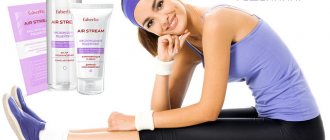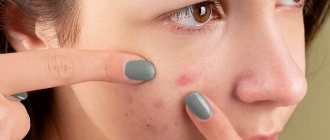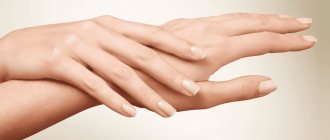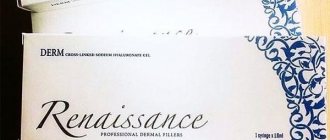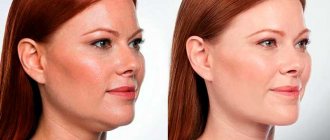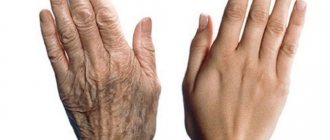Excision of the scar with the application of cosmetic sutures.
Excision of the scar with the application of cosmetic sutures is usually the first (and often the only necessary) step in scar correction.
Scar excision is necessary if:
- the scar is retracted
- edges are matched at different levels
- the edges are shifted along the axis of the scar
- pronounced scar hypertrophy
- wide scar
- the scar deforms the contour of the lips, eyes, etc.
- the scar limits joint mobility
It's no secret that a suture made by a plastic surgeon will differ significantly from a standard surgical suture or scar formed after wound healing without sutures.
Lipofilling.
Lipofilling is intended to correct defects of subcutaneous fatty tissue (depressions) in the scar area. Filling of the depressions occurs due to the transplantation of one's own fat cells. Lipofilling is indicated in cases where the scar itself is thin or pinpointed, and a clear retraction of soft tissue is determined underneath it. A classic example is the correction of deep post-acne “scars”, when upon careful examination the actual scar on the skin is almost invisible, but a depression in the subcutaneous fatty tissue is noticeable.
Operating principle
Phonophoresis causes ultrasonic mechanical vibrations that can penetrate the skin to a depth of 4 to 6 cm. In addition to delivering lidase or other medications directly to the site of the disease, micromassage of the body’s tissues and cells also occurs during the procedure. The result is an improvement in local blood flow and cellular metabolism, a reduction in swelling due to the lymphatic drainage effect and an acceleration of natural regeneration. Also, phonophoresis with lidase allows you to eliminate pain and inflammation. In this case, lidase accumulates under the skin, entering the blood not immediately, but gradually, which makes its therapeutic effect more prolonged and, as a result, more effective.
Injections of scar-absorbing drugs.
Injections of scar-absorbing drugs are used in cases of formation of keloid and hypertrophic scars, and the need to level small elevations in the scar area.
A hypertrophic scar rises above the surface of the skin and has a significant width. A keloid scar in the initial stages is similar to a hypertrophic one, but is distinguished by rapid aggressive growth with the germination of surrounding healthy tissue.
Most often, injections of hyaluronidase (Longidase, Lidaza) and Diprospan are used for resolving purposes.
Hyaluronidase causes the breakdown of hyaluronic acid in the scar, making it softer and flatter, but, unfortunately, the effect of hyaluronidase is very moderate and reversible and after the end of the course of injections the scar often takes on its previous appearance.
Diprospan has a more pronounced effect of resorption of scar tissue, not only reducing the convexity of the scar, but also stopping its growth. The effect obtained from diprospan injections lasts for life.
It should be noted that although diprospan is a hormonal drug, there are practically no side effects on the entire body when treating scars. This is due to the fact that all the side effects described in the instructions for diprospan occur when using the usual average therapeutic doses (1 ml once a week).
In plastic surgery, incomparably smaller doses of 0.01-0.02 ml are used to resolve scars once every 2 weeks, and sometimes less often.
The sooner scar treatment is started, the better the result will be. It is important to continue treatment until the scar has completely stopped growing. After completing the course of treatment, observation by a plastic surgeon is necessary for 2-4 weeks.
Treatment with diprospan can be combined with the use of other methods of scar correction.
Diprospan injections for scar correction can only be performed by a plastic surgeon.
Return to how it was: remove fillers with Lidaza
Contour plastic surgery is considered a safe procedure with predictable results. But sometimes things don’t happen at all the way you wanted. Perhaps the cosmetologist’s hand trembled and he injected the drug in the wrong place and in the wrong quantity, perhaps the body reacted with hostility to the injections, or maybe new plump lips simply did not suit you - in such cases you want to return everything as it was, and in the shortest possible time!
For a long time, patients dissatisfied with the results of “beauty injections” had only one option - wait 6-12 months until the filler naturally dissipates. But not so long ago, cosmetologists acquired a new tool for correcting mistakes - hyaluronidase, which in the Russian Federation is produced under the brands “Lidaza”, “Longidaza”, etc. This is a special enzyme that allows you to many times accelerate the resorption and removal of hyaluronic acid (HA) from areas of unsuccessful correction.
How does this product work and what fillers can be removed with it? Are there any side effects and how much will this procedure cost? Read the detailed review of TecRussia.ru:
↑ How does it work?
In medicine, including aesthetic medicine, drugs are used based on testicular hyaluronidase, isolated from the testes of cattle, sometimes pigs or sheep. It doesn’t sound particularly attractive, but this extract solves patients’ problems very effectively. In cosmetology, it was originally used as a means to combat cellulite fibrosis. Now its most significant function is the accelerated biodegradation of hyaluronic acid.
- How to remove lip fillers: advice from our experts
Without going into a detailed description of the chemical processes, the operating principle is as follows: the biological activity of the introduced enzyme leads to the destruction of the molecular bonds of HA, its long oligomers are fragmented into shorter pieces, which are then easily removed from the body naturally. As a result, if the cosmetologist does not make a mistake with the dosage and location of the injections, within 48 hours all the consequences of unsuccessful contouring will be eliminated.
↑ How to choose the right drug
The most popular hyaluronidase-based product on the Russian market is Lidaza, which has been successfully used in dermatology, gynecology, surgery for quite a long time, and has recently become a bestseller in cosmetology. Two more of its analogues are slightly less popular - “Longidaza” and “Liraza”. This is a rare case when domestically produced cosmetic products turned out to be more famous than similar brands of foreign origin.
| A drug | Reg. No. | price, rub. |
| Longidaza | LS-000764 | from 1400 |
| Lidaza | P N000820/01 | from 250 |
| Liraza | R No. 000841/01-2001 | from 1300 |
Hyaluronidase is also produced abroad. Examples of drugs:
| Name | Manufacturer | Price, euro |
| Amphadase 150 | Amphastar Pharmaceuticals, Inc. | 1500 |
| Vitrase Ovine | Alliance Medical Products, Inc., USA | 600 |
| Inno-tds Hyaluronidase (1500 IU) | Innoaesthetics, Spain | from 200 |
| Liporase or LDRase | Global Trading Co., Korea | from 95 |
| Hylase "Dessau" | RIEMSER Pharma GmbH, Germany | from 30 |
None of them are officially registered in Russia - however, for private use they can be ordered via the Internet. But, judging by the reviews, there is not much point in this, since domestic products do an excellent job and are several times cheaper.
↑ What cosmetic problems do Lidaza and its analogues solve?
Enzyme preparations that destroy HA are needed in the following cases:
- excessive and/or uneven administration of the gel during contouring - if after the procedure bumps, irregularities, and asymmetry appear on the face (including facial expressions);
- too superficial injections in areas with thin skin - in this case, the hyaluronic acid will shine through, giving a bluish tint;
- the appearance of granulomas;
- subjective discomfort from the filler - a feeling of a foreign body.
Let's take a closer look at the most common indications:
- Elimination of overcorrection. Excessive volume of injectable gel can deprive facial features of naturalness, distort them, migrating to neighboring areas. This problem is especially noticeable in the periorbital region, when HA is administered to smooth out crow's feet, eliminate dark circles under the eyes or the nasolacrimal groove. Instead of rejuvenation, the patient receives “edema” or bulging of the drug. Lidaza can either remove excess HA or completely remove all filler - it all depends on the patient’s wishes and the correct dosage.
- Tyndall effect. If the hyaluronic filler is introduced superficially or in excessive quantities, it, firstly, begins to stick out as a noticeable bump, and secondly, it begins to show through with a characteristic blue tint. This problem is called the Tyndall effect and most often occurs when correcting the area under the eyes, where the skin is especially thin and delicate. In this case, hyaluronidase is also injected superficially, exactly into the area of the implanted HA. The smoothing of the skin and the elimination of blue discoloration are noticeable within half an hour after the procedure.
- Treatment of granulomas. Sometimes our body perceives the filler as an object hostile to it and turns on a “protective mode”. During the immune reaction, a granuloma appears - a tumor-like formation, which can be accompanied by symptoms of inflammation. Lidase breaks the hyaluronic acid polymer into short fragments, which our immune system no longer perceives as hostile. The inflammatory process quickly ends, the seal disappears.
- Prevention of necrosis. This condition is considered one of the most serious complications after contouring. It develops due to the fact that the injected gel compresses the vessel and blocks blood flow to the tissues, which as a result begin to die. The main symptoms are whitening of the skin in the injection area, soreness or numbness. The situation requires the immediate introduction of hyaluronidase-based products: it will destroy hyaluronic acid, restore blood flow and significantly reduce the area affected by necrosis. The main thing here is to hurry up, because the longer the time has passed since the onset of ischemia, the more dangerous its consequences can be.
| Photos before and after injections of Lidase (hyaluronidase). Upper lip correction: | |
| Removing incorrectly inserted filler from under the eyes: | |
↑ What else is important to pay attention to?
Injections of Lidase or its analogues lead to rapid resorption of stabilized HA. At the same time, they will not have any effect on other components used in contour plastic surgery - for example, silicone, collagen or polylactic acid. Therefore, cosmetologists always administer such “persistent” gels as Radiesse and Ellanse with extreme caution: if something goes wrong, it will be extremely difficult to remove them from the body.
But even with hyaluronic acid there can be problems - its density and strength, which are indicated by the cumulative indicator G' (G-stroke), are of great importance. The higher the G-bar, the more stable the filler and the more difficult it is to break. At the same time, even for drugs with similar effects, it can differ significantly:
- for example, for the Juvederm Ultra line G' ranges from 28 to 139, and for Restylane it is already more than 500.
That is why a cosmetologist needs to know what specific gel and in what quantity was used for contouring. This makes it easier for him to choose the right dosage for correction.
↑ How the procedure works
The introduction of gailuronidase consists of several sequential injections, their number depends on the area of the treated area and the amount of filler that needs to be removed. At the same time, 70% of success lies in the preparatory work:
- examination of the patient, collection of information about the volume and type of previously administered injection gels;
- calculation of the required volume and concentration of the enzyme;
- conducting an allergy test - a small amount of the drug is applied to a scratch on the skin to make sure there are no adverse reactions.
Next, the doctor dilutes the required amount of Lidase, Longidase or another selected agent in a sterile saline solution, sometimes with the addition of an anesthetic, and injects into areas that require correction. The sensation is not pleasant: patients often complain of increased pain, even despite the use of an anesthetic. But it's worth it, because the results will be more than pronounced:
- The decrease in the volume of previously introduced hyaluronic acid will be noticeable within 1-2 days. Often the first effect is visible within 30 minutes after the procedure.
- A follow-up examination of the patient is carried out after 1-2 weeks, when swelling and edema have completely disappeared. If the result is still insufficient, a little more enzyme is added at this stage.
- A new contouring session can be planned no earlier than 2-3 weeks later.
↑ Contraindications, possible complications and side effects
Hyaluronidase could be considered a salvation for cosmetologists and their patients. The lips turned out to be too pouty, you didn’t like the new cheekbones, the filler got in the way, contoured, or even crept somewhere in the wrong place - one or two injections will fix everything. If not for one “but” - the risk of complications and side effects. The most common of them:
- Allergy: Since we are talking about a drug based on animal protein, unwanted immune reactions are not so rare, even despite the mandatory allergy test. Their intensity can be very serious - from swelling in the injection area and itching to anaphylactic shock. Frequent symptoms: fever, nausea, difficulty breathing. That is why the patient, after administration of Lidase, Longidase, etc. must be under the supervision of a doctor in the clinic for at least an hour, and also listen carefully and remember well all the instructions of the cosmetologist in case of delayed allergic reactions.
- Hypercorrection. Calculating the correct dose is a fine job. It is not difficult to overdo it and dissolve all the filler completely, although the patient only needed a slight adjustment of its amount. In addition, even experienced cosmetologists cannot predict how hyaluronidase will behave in the body of a particular patient.
- Undesirable interactions with other drugs: taking antihistamines and hormonal drugs reduces the effectiveness of any hyaluronidase-based product. And Longidase has an additional limitation: it should not be taken simultaneously with medications containing furosemide, benzodiazepines, or phenytoin.
↑ The main thing is not to overdo it
- The largest number of horror stories on forums are based on stories about how hyaluronidase “eats” its own tissues, leaving noticeable holes and gaps on the face. And, unfortunately, judging by the reviews, such defects last a very long time, sometimes for 1.5-2 years. At the same time, many cosmetologists claim that neither Lidaza nor Longidaza are capable of “corroding” tissue. And the consequences listed in the reviews of the “victims” are either the manifestation of fibrotic processes that form the edges of the “pit”, or the results of an experimental technique when hyaluronidase is mixed with diprospan to enhance the effect. These irregularities can be closed using secondary correction with fillers.
- Another theoretical risk from hyaluronidase injections is the removal from the body of not only the filler, but also its own reserves of hyaluronic acid. This may affect the quality of the skin (it becomes drier), but after a while the BG level is restored naturally.
- In any case, experts have the opinion that it is better not to inject the drug than to inject it. Experts advise introducing very weak concentrations of the enzyme, dividing the correction into several stages. Thus, it is possible to carry out the procedure more reliably and safer for the patient.
Hyaluronidase preparations - Lidaza, Longidaza, etc. - are very effective for the resorption of hyaluronic fillers. This is both their advantage and their disadvantage. In the hands of an amateur, they can do more harm than good. To reduce the risk of allergies, so that correction does not result in new problems, entrust the procedure only to a professional cosmetologist with practical experience in such work.
Mesotherapy.
Mesotherapy is a series of superficial injections of special drugs into the scar area at intervals from 3 days to 1 month.
Mesotherapy is required in cases where the scar is darker in color compared to the surrounding tissue. The dark color of the scar is not a pathological course of scarring processes. Usually, the reddish coloration of the scar is followed by a dark coloration of the area around the scar, and after a few months the scar and the area around it lighten. Sometimes this process takes longer. Then mesotherapy is used. Mesotherapy is a course procedure performed by cosmetologists.
Use with Fermenkol
Phonophoresis with Fermenkol gel allows you to deliver hyaluronic acid deep into the skin, which is an excellent alternative to lidase and traumatic “beauty injections”, and effectively eliminates scars. During the procedure, the skin is subjected to soft micromassage and lymphatic drainage. Due to this, a lasting lifting effect is achieved, muscle tone increases, tissues are warmed up and better supplied with oxygen, which leads to rejuvenation and the return of freshness.
Silicone plates Cerederm.
Cerederm is a transparent self-adhesive silicone film. Cerederm is applied to clean, dry skin in the form of strips covering the scar and 0.7-1 cm of skin around the scar. The strips are changed once every 2-3 days. To achieve the effect, you need to wear Cerederm around the clock for several months until the scar turns white.
Silicone can be used as an independent treatment for scars, or in combination with other measures that stop further growth of the scar.
Plasmalifting and microfatgrafting.
Plasmalifting is the treatment of scars with a drug obtained from a person’s own blood. Plasmalifting is used to correct small pinpoint irregularities up to 1 mm deep, for example post-acne. Plasmalifting is a cosmetic injection procedure performed at intervals of 3-4 weeks. Typically 3-7 procedures are performed to achieve the desired results.
Microfatgrafting.
Microfat grafting is the transplantation of micrografts (up to 1-2 mm) of one’s own adipose tissue into the scar area. Microfatgrafting is indicated in the following cases:
- small pinpoint scars 1-2 mm deep (post-acne)
- superficial hypotrophic scars
- thin hypotrophic scars.
- striae
- residual retractions after scar lipofilling.
- Wrinkles
Microfat grafting is performed by a plastic surgeon. The collection and planting of micrografts is carried out using a syringe without skin incisions.
Features of application
The use of ultrasound to introduce lidase into the body is painless for the patient, which is very important for severe pain in a problem area. The skin, with proper dosage and handling of the phonophoresis apparatus, remains intact. Also, large doses of the drug are not required - a small amount of lidase is enough to obtain a long-lasting and lasting therapeutic effect. In this case, the procedure does not cause any side effects, since lidase enters the body through the transdermal (transdermal) route, without being absorbed in the gastrointestinal tract.
A course of treatment with phonophoresis with lidase allows you to restore blood circulation, lymph flow and microcirculation, eliminate stretch marks and scar tissue of any age. Cosmetologists successfully use this procedure to eliminate cellulite and wrinkles, since ultrasound in combination with lidase warms up and saturates tissues with life-giving oxygen, restores healthy collagen and elastin fibers. As a result, the connective tissue and skin become elastic and healthy.



